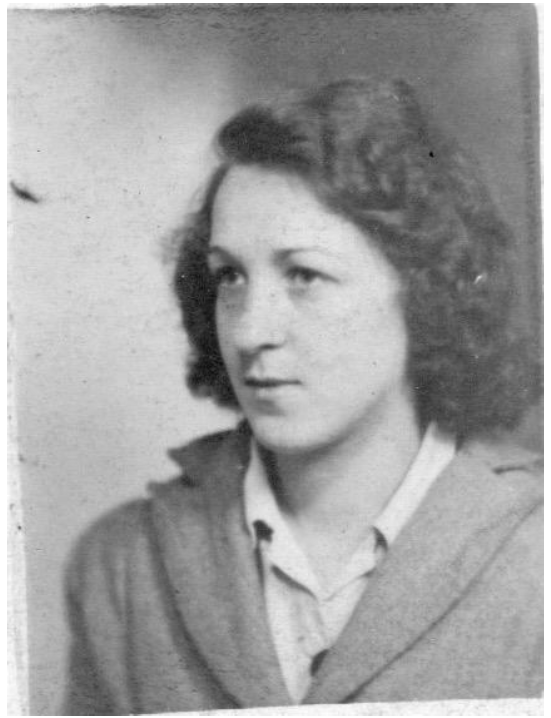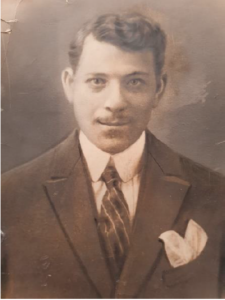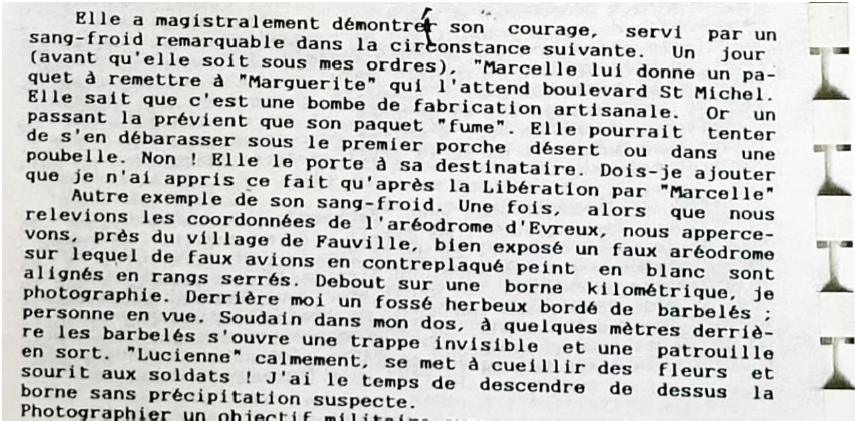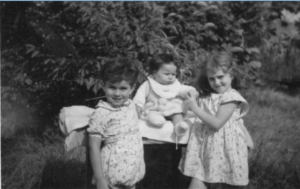Elisa MARCU
The biography that you are about to read was researched and written by Marena Abou Eliamin, Héloïse Bourgeois, Aïssam Cherid, Sarah Combettes, Mélanie Forçard, Giovanni Guigui, Maëlys Ngono and Cassandre René-Dit-Bois, 9th grade students at the La Cerisaie middle school in Charenton-le-Pont, in the Val-de-Marne department of France, with the guidance of Nathalie Baron and Sonia Drapier, their History and Geography teachers. It was written during the 2023-2024 school year.
We were lucky enough to track down Jean-Pierre Fayer, Elisa Marcu’s son, on the Internet. We would like to thank both him and his family for all their help with our research, for providing us with various records and for coming to our school to meet us. We would also like to thank Jacques Gragnon and Philippe Roza, who also contributed to our research. We are happy to have this opportunity to share Elisa’s biography with you. Our fellow students have also written the biographies of Elisa’s father, Ilie Marcu and her brother Manuel Marcu, and these too can be found on the Convoy 77 website.
Our research was based on records from the Val de Marne Departmental archives, the French Historical Defense Service Memorial in Caen, Normandy (DAVCC file 21P 644 268), the Shoah Memorial in Paris, the Paris Police Headquarters and the Arolsen Archives.
We urge you to read the life story of this courageous woman who used various first names over the course of her life: she was known as Elisa, Lucienne and Léa. We have opted to call her Elisa, the name she given at birth, throughout.
I- 1921-1939: growing up in a Romanian family
Elisa Marcu was born at around 6:30 a.m. on March 08, 1921, in the family home at 3 rue Puteaux, in the 17th district of Paris. Her parents were originally Romanian but had become naturalized as French citizens. When her parents, Ilie Marcu and Blanche Leibovici, moved to France, in 1913 in Ilie’s case, her paternal grandparents, Leid and Itie Hers-sin Marcu, stayed behind in Negresti, in Romania. Her maternal grandmother, Sara Leibovici, lived in Codăești, also in Romania.
Ilie and Blanche Marcu – date unknown
Source: Marcu-Fayer family archives
Elisa Marcu as a child – date unknown
Source: Marcu-Fayer family archives
Elisa had three brothers: Isaac, who was born on February10, 1915, Jean, born on September 12, 1918 and Manuel, born on May 8, 1927. All four children were born in Paris.
Photo of the Marcu family (Elisa on bottom left) – date unknown
Source: Marcu-Fayer family archives
According to Ilie and Blanche’s marriage certificate, the Marcu family initially lived at 3 rue de Puteaux, in the 17th district of Paris. They then moved to 12 rue du commandant Mowat in Vincennes in the early 1930s. Ilie had been renting premises for his shoemaking business at 4 place Bérault in Vincennes since 1926, while Blanche did not work outside the home.
Extract from the 1936 census of Vincennes
Val de Marne departmental archives
Elisa was 18 years old when her mother, Blanche, died as a result of diabetes on June 22, 1939 in the 12th district of Paris.
Ilie subsequently met a new partner, about whom we know very little. Elisa only referred to the existence of her stepmother in her letter, and mentioned her to one of her fellow Resistance members, Victor Gragnon, who, in his biography, noted that Elisa’s stepmother baked fine pastries.
The 1946 census of Vincennes lists Elisa, her brothers, Jean’s wife Irène and Ilie. The whole family was included in the census, although Ilie, Isaac and Manuel never returned from the camps.
We have also written biographies of Ilie and Manuel, which include some additional information and are also on the Convoy 77 website.
According to Elisa’s son, Jean-Pierre Fayer, whom we met, Elisa went to the Est elementary school in Vincennes and went on to train as a dressmaker.
Elisa grew up in a family of communists and resistance fighters.
Her father, Ilie, was an activist in Romania before he joined the French Communist Party. During our research, we came across a document in the Paris Police Headquarters archives relating to a search of the family apartment and Ilie’s shoemaking business that took place at 3 p.m. on June 26, 1940. The report states that no weapons were found, but that various documents were seized. These included a French Communist Party membership card from 1937, a card for the French – Soviet association in Paris dated 1938, two postcards addressed to Isaac that included communist slogans, two letters addressed to Jean about communist issues, and a notebook featuring a hammer and sickle.
As for Elisa, her son Jean-Pierre Fayer told us that his mother was a member of the young women’s communist movement. In 1936, she joined the Jeunes Filles de France (Young Women of France), a political organization linked to the Fédération des jeunesses communistes de France (Federation of Young Communists of France) which was founded by Danielle Casanova. She joined the Resistance in 1939.
II- 1939-1944: Elisa’s involvement in the Resistance
In addition to her son’s testimony, several written sources confirm that Elisa took part in various resistance operations. These include:
- A letter, dated March 2, 1987, written by Elisa herself. It is addressed to Jacques Gragnon, the son of Victor Gragnon (who was the head of intelligence for the FTPF, the Francs-Tireurs et Partisans, an armed resistance organization founded by the leaders of the French communist party). This letter was donated to the Shoah Memorial.
- The biography of Victor Gragnon, written by Georges Sentis as part of the Committees for the History of the Resistance Institute for Marxist Research organization.
- A certificate signed by René Camphin (the national leader of the FTPF) confirming Elisa’s involvement in numerous FTPF operations.
Certificate signed by René Camphin attesting to Elisa Marcu’s Resistance activities, September 14, 1945. Source: Caen Memorial archives
Victor Gragnon stated that she was “involved in all the activities carried out since September 1939 by the young [women of France] under the leadership of Danielle Casanova, […] whom she met in a square in Montreuil”.
As Elisa herself confirms in her letter, she joined the Communist Party in 1941 in Vincennes.
Her Resistance codename was “Lucienne”. She took part in a raid on Rue de Buci on May 31, 1942. That day, amid stringent rationing, a dozen women led by Madeleine Marzin broke into a store called Eco on the Rue de Buci in Paris. Stocks were plentiful, as the Germans went there to replenish their supplies. The women took groceries and gave them to the housewives waiting in line, while the FTPF distributed leaflets outside. As a result of this raid, many people were arrested, including 9 activists, but Elisa was not one of them.
Elisa was appointed liaison officer and was assigned to the B service, then to the FANA (the FTP intelligence service). René Camphin attested that she was assigned to the 3rd liaison and communications department of the du FTPF National Military Committee, attached to the 2nd office of the National General Staff, a position corresponding to the rank of second lieutenant in the FFI (Forces françaises de l’intérieur, or French interior forces).
Victor Gragnon, whose codename was “Gaspard”, described a number of resistance operations in which Elisa / “Lucienne” played an important role. She gathered together intelligence “gathered by all the offshoots of the FANA branch”. She also passed on numerous papers to Victor Gragnon: “clandestine newspapers, CMN circulars from the FTP, Front Nationale and PCF, requests for information, false papers, ration coupons for [the] permanent informers, funds and much more”. Elisa acted as Victor Gragnon’s scout during so-called “hazardous” meetings. First “Bernard” and then “Dubreuil”, successive heads of Service B, set up meetings between Victor Gragnon and strangers, male or female, advising him to proceed with caution. “Lucienne’s” task was to go ahead of him to the meeting place and look out for anything suspicious. Lucienne teamed up with Gaspard on many occasions to provide information. They appear to have been quite close before the war, and their missions often involved geographical reconnaissance (locating airfields, taking photos etc.).
In the biography written by Georges Sentis, Victor Gragnon recounted several episodes that demonstrate how courageous Elisa was:
Extract from “Victor Gragnon: à la tête du réseau F.A.N.A (service B des FTPF)” by Georges Sentis for the Committees for the History of the Resistance Institute for Marxist Research organization.
Further evidence of Elisa’s Resistance involvement comes in the form of a weapons manual that was hidden inside the cover of a book about the Scouts, so that she could read it inconspicuously on public transport. Elisa’s descendants still have this book.
Throughout this period, Elisa lived in hiding, separated from her family. It seems that she spent some time in Versailles with Victor Gragnon, and also in Pantin, where she stayed with the Weinstein family, who still keep in touch with her children.
III- 1944-1945: arrest and deportation
In her letter, held at the Shoah Memorial, Elisa wrote: “On the orders of the party, I left my family. But I was very fond of my family. One Sunday in July 1944 (I think it was the 24th), I went out into the countryside with my brother, who was only 17. We were reported by a neighbor. That day, 17 of us were arrested”. In his biography, Victor Gragnon states that some party members, including himself, “Gaspard”, as well as their leader “Bernard”, had told Elisa quite specifically that she must not meet up with her family.
Nevertheless, in July 1944, although the situation remained dangerous, the family got together in a county house in Les Courdreaux, near Courtry, in what is now the Seine et Marne department of France, and Elisa went with them.
The following photo was probably taken there. It pictures Elisa, Blanche, Jean and Manuel, flanked by two of their cousins, Maurice on the left and Henri on the right.
Family photo taken in Courtry – date unknown
Source: Marcu-Fayer family archives
Jean-Pierre Fayer told us that the Marcu family had been reported by a neighbor, a “white” Russian refugee in France. According to the records, Ilie, Elisa and Manuel were actually arrested on Sunday July 23, 1944, along with 17 other people who were not members of the family. One record also includes Aldolphe Leibovici and his wife, who may have been Blanche’s brother and sister-in-law.
The whole neighborhood witnessed the arrest, including a Mr. or Mrs. Leclerc and Mrs. Lebord, according to Elisa’s file in the Caen Memorial Archives, as did the Mayor of Courtry, according to Ilie’s file. We have been unable to trace any of them.
Research undertaken at our request by the Historical Society of Claye and the surrounding area identified a woman from Courtry who was 10 years old in 1944. She remembers a Jewish family being arrested in the town, one of whom was a shoemaker. He must have been Elisa’s father, Ilie. Someone else remembers her grandmother telling her that she had kept a Jewish couple hidden for a short time, but that they then sought refuge elsewhere.
While they were all on a bus on their way to Drancy camp, Jean-Pierre Fayer told us that Elisa’s father, Ilie, threw a short, handwritten message out of the window, which he wanted to be forwarded. The note was addressed to a Mr. Pagès, who lived at 2 place Bérault in Vincennes. Jean-Pierre still has this handwritten note, a sad reminder of what happened to his family.
Ilie’s handwritten note
Source: Marcu-Fayer family archives
Elisa, Ilie and Manuel arrived at Drancy camp later on July 23, 1944.
The letter B on the record card below signifies that she was subject to immediate deportation. She was interned in room 4 on staircase 3, together with her father and younger brother. She was initially interned in the same room as her father and younger brother. However, Ilie and Manuel were then moved to room 3 on staircase 4, while Elisa was moved to room 2.
After having been interned in Drancy, Elisa, along with 1305 other prisoners, was deported to Auschwitz on Convoy 77 on July 31, 1944. The convoy left Drancy, travelled through northern France and Germany and finally arrived at the Auschwitz concentration camp in Poland.
Elisa’s internment card from Drancy camp
Source: Shoah Memorial, Paris
All three members of the Marcu family survived the journey from Drancy to Auschwitz-Birkenau. We have only some vague and/or contradictory information about what happened to Manuel and Ilie when they arrived at Auschwitz, but we can confirm that they never returned from the camps, whereas Elisa did.
We have very little information about Elisa’s life in the camps, as she herself never gave a detailed account of this traumatic period, either in her letter dated March 2, 1987, or to members of her family. Whenever she spoke to her family, Elisa mentioned very little about what happened, but did describe the interminable early morning rollcalls in the bitterly cold winter. Her son also told us that since she had so little to eat in the camps, she continued to chew her food very slowly for the rest of her life.
We know that Elisa arrived at Auschwitz-Birkenau on the night of August 2 to 3, 1944. She had the number A 16 767 tattooed on her left forearm. It would seem that she was soon transferred to the Kratzau labor camp, which was a sub-camp of Gross-Rosen in Czechoslovakia.
Elisa Marcu’s medical record
Source: Caen Memorial archives
(Elisa FAYER née MARCU, DAVCC 21P 644 268)
We do not know what type of work Elisa did during her time in Kratzau, but we do know that she made friends there, in particular with Hélène Ramet and Suzanne Hoffnung. Also, when Suzanne Hoffnung applied to be granted the status of political deportee, Elisa was one of the witnesses who testified that the Gestapo arrested Suzanne “on racial grounds”.
The biographies of Necha Goldsztejn, Germaine Wagensberg and Yvette Levy, which are also on the Convoy 77 website, include further details the living conditions in Kratzau.
IV – 1945-2019: Elisa’s return to life in France
On May 9, 1945, the Red Army liberated the Kratzau camp, and Elisa, along with the other survivors, returned home to France. We have only limited details about the route she took, but along with some of the other girls, she probably passed through Prague. Her medical card states that she weighed around 105 pounds when she got back, that her overall state of health was “average”, and that she needed some dental treatment and an X-ray. The same form says that she returned home by rail. Several records state that she was repatriated to France on May 24, 1945. She arrived in Sarreguemines in the Lorraine region and was then taken to the Lutetia Hotel in Paris, which was used as a reception center for people returning from the camps.
Information verification form
Source: Caen Memorial archives
(Elisa FAYER née MARCU, DAVCC 21P 644 268)
We do not know exactly when Elisa met back up with her brother, Jean, but they both moved back into the former family home at 12 rue Commandant Mowat in Vincennes.
Jean took over their father’s shoemaking business, and on December 29, 1945, Elisa married Pierre Henri Fayer, who lived next door to her before the war and was also a member of the Communist Party.
Elisa Marcu and Pierre Henri Fayer’s marriage certificate
Source: Caen Memorial (Elisa Fayer née Marcu, ref. DAVCC 21P 644 268)
Elisa and Pierre Henri Fayer had three children: Evelyne, who was born on April 15, 1946, Jean-Pierre, born January 21, 1949 and Elisabeth, born March 3, 1953. Pierre Henri worked as a typographer, while Elisa, as well as raising their three children, was an active member of the French Women’s Group of the Communist Party. According to their son Jean-Pierre, Elisa appeared on the party’s electoral lists in Vincennes. Within the family, Elisa was known as “Léa”, and this is the name on the back of one of the photos provided by Jean-Pierre.
Elisa, Pierre Henri and their daughters – date unknown
(Source: Marcu-Fayer family archives)
Elisa and Pierre Henri Fayer’s three children: Jean-Pierre, Elisabeth and Evelyne
(Source: Marcu-Fayer family archives)
On March 14 1955, Elisa was granted the official title of “political deportee”, meaning that she had been deported on political grounds. Her work as a Resistance fighter was never officially recognized, despite her having been a second lieutenant in the FFI (Free French Forces).
Elisa kept the country house in Courtry, where she stayed on vacation with her children, for the rest of her life. The person who had denounced them still lived there, but Jean-Pierre Fayer says that the family had no interest in taking revenge. Nevertheless, the records suggest that some of her former Resistance colleagues would like to have done so.
Elisa often met up with her “girlfriends from the camps”, especially Hélène Ramet and Suzanne Hoffnung. She told her family very little about what happened when she was deported, but probably shared her memories with the other women who had lived through similar experiences.
Elisa died on May 11, 2019 at the age of 98, leaving behind a large family.
Reunion of former deportees in Nancy, France, on May 9, 1993.
Elisa Fayer is in the 3rd row from the top, 2nd from the left, in white.
Source: Yvette Levy


 Français
Français Polski
Polski

























